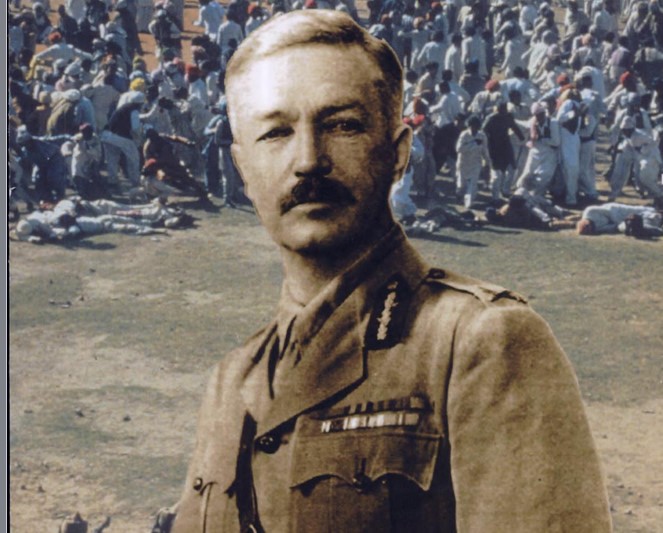While Pooja Shakun Pandey of the Hindu Maha Sabha called for a genocide of Muslims at the Dharam Sansad in Hardwar in 2021, Shiv Sena (Shinde) leader Sanjay Nirupam recently threated to unleash another Jallianwala Bagh massacre targeting Muslim protestors.
By P.K.Balachandran
Colombo, April 10 – In December 2021, the media reported that Sadhvi Annapurna aka Pooja Shakun Pandey of the Hindu Mahasabha gave a call for the massacre of Muslims at the Dharam Sansad held in Hardwar in December 20211. And in April this year, a video on social media showed Sanjay Nirupam of Shiv Sena (Shinde group), threatening a Jalliianwala Bagh-type massacre of Muslims if they dared to demonstrate against the Waqf Amendment Bill.
The fertile but warped creativity of the Hindutva brigade is coming up with new ways of othering the Muslims of India with each passing day, motivated by an insatiable greed for the votes of the majority Hindus.
Threatening mass murder appears to be the flavour of the times.
According to the media, Pooja Shakun Pandey, a general secretary of the Hindu Mahasabha said in deceber 2021, “Nothing is possible without weapons. If you want to eliminate their (Muslims’) population then kill them. Be ready to kill and be ready to go to jail. Even if 100 of us are ready to kill 20 lakhs of them (Muslims), then we will be victorious, and go to jail… Like [Nathuram] Godse, I am ready to be maligned, but I will pick up arms to defend my Hindutva from every demon who is a threat to my religion.”
Fast forward to April 2025. A video which went viral over the social media showed Sanjay Nirupam, a top Mumbai politician of the Eknath Shinde-led Shiv Sena, warning Muslims that if they agitated against the Waqf (Amendment) Bill as they did against the Citizenship Amendment Act i(CAA) in 2019-20, they could “create a Jallianwala Bagh type of situation.”
Nirupam, a former Congress bigwig in Mumbai and a recent defector to Shiv Sena (Shinde faction), was reacting to an announcement by the All-India Muslim Law Board (AIMLB) that if parliament passed the Waqf Amendment Bill, the country would witness another ‘Shaheen Bagh’—a reference to the peaceful protests against the CAA at Shaheen Bagh in Delhi in 2019-20.
Timing of Nirupam’s Threat
The timing of Nirupam’s threat was not lost on the viewers. It was on April 13, 1919, that 379 Indians who were peacefully staging an anti-British protest in Amritsar’s Jallianwala Bagh, were massacred by British-led Indian army troops in one swell swoop lasting just ten minutes.
Although the British had won the 1914-18 World War I against Germany and Islamic Turkey, fears about being overpowered by a resurgent Russia under Communism arose. The British were convinced that Russia will continue the Tsarist “Great Game” of adding India to their Empire. Communism could also support India’s freedom struggle then gathering steam with Gandhi’s arrival from South Africa.
These fears were compounded by the support that the Emir of Afghanistan Amanullah Khan was giving to the Indian freedom struggle. In fact, Amallnullah Khan invaded India in May 1919, just a month after the Jallianwala massacre.
Immediately after the Rowlatt Act was passed in March 1919, Mahatma Gandhi called for country-wide Hartals which turned violent at places. With Hindu-Muslim unity emerging, the British were worried about their ability to hold on to India. A repeat of the 1857 revolt in which Hindus and Muslims fought shoulder to shoulder was feared.
On April 9, 1919, Hindus in Amritsar came together to celebrate Ramnavami. But a paranoid Brig.Gen. Reginald Dyer, commandant of the Amritsar Cantonment, instructed Sir Miles Irving, the Deputy Commissioner of Amritsar, to arrest two leaders, Dr.Satyapal, a Hindu medical doctor and Dr.Saifuddin Kitchlew, a Muslim Barrister.
In response, people closed their shops and staged street protests. As the crowed approached the railway station overbridge, the army opened fire killing 24. Subsequently, an angry mob of around 40,000 killed five Englishmen. Over two dozen government buildings were damaged.
As the crowd reached Kucha Korian Street in Lohgarh, they encountered one Miss Marcella Sherwood, a Church of England missionary. She was beaten with sticks and left for dead. But some locals rescued her.
Gen.Dyer sought to avenge the humiliation of Ms.Sherwood. For days on end, he forced Indians to crawl on their bellies if they wanted to use Kucha Korian street. His justification was that the Hindus would not mind the crawling order because they crawled on their bellies in their temples for their female goddesses, and missionary Sherwood was no less a Goddess.
Jallianwala Bagh incident
On the morning of 13 April, Dyer issued clamped a curfew. But a defiant crowd of about 5000, led by one Dr.Mohammed Bashir, headed for a meeting in Jallianwala Bagh, a two hectare ground with five entry-exit points. The first thing that Dyer did was to seal four of them, leaving one for his 50-strong army detachment comprising Gurkha and Baloch troops to enter.
As a poem was being recited, Gen.Dyer, ordered to fire “to kill”. The ten-minute barrage of bullets left 379 dead, including 41 women and a child. Over 1200 were injured, many seriously. If the two armoured cars with machine guns mounted them that had been brought were used, thousands would have been killed. But the street was too narrow for the armoured cars.
According to Nigel Collett, author of “The Butcher of Amritsar” (2006), Dyer was unrepentant. He told a delegation of Indians, “You people know well that I am a soldier and a military man. Do you want war or peace? If you wish for a war, the Government is prepared for it, and if you want peace, then obey my orders and open all your shops; else I will shoot. For me the battlefield of France or Amritsar is the same.”
The Aftermath
Shockwaves from Jallianwala Bagh shook India. Nobel Laureate Rabindranath Tagore returned his knighthood and Gandhi launched the Non-Cooperation Movement in 1920. But there were mixed reactions in Britain. While The Morning Post declared Dyer as “the man who saved India” Edwin Samuel Montagu, the Secretary of State for India, asked in the House of Commons, “Are you going to keep your hold on India by terrorism, racial humiliation, subordination and frightfulness, or are you going to rest it upon the goodwill and the growing goodwill of the people of your Indian Empire?”
Even rank imperialist Winston Churchill, Secretary of State for War, called the massacre “an episode without precedent or parallel in the modern history of the British Empire … an extraordinary event, a monstrous event, an event which stands in singular and sinister isolation … the crowd was neither armed nor attacking.”
The Leader of the Liberal Party and former Prime Minister H. H. Asquith, observed: “There has never been such an incident in the whole annals of Anglo-Indian history, nor, I believe, in the history of our empire since its very inception down to present day. It is one of the worst outrages in the whole of our history.” In 1920, the Labour Party unanimously passed a resolution denouncing the Amritsar massacre as a “cruel and barbarous action”.
But Dyer stood firm. In article in the Globe of 21 January 1921, entitled, “The Peril to the Empire”, (Quoted by Colette) Dyer wrote, “There should be an eleventh commandment in India – Thou shalt not agitate. All that the cultivator and the factory worker wants is just and clear laws applicable to all alike. He does not always know why his passions have been roused and whether he is being misled, who is there to tell him but the Sahib? And now it seems that the Sahib is not allowed to tell him. He does not want an exchange of rulers.”
“India will not be desirous or capable of self-government for generations, and when self-government does come, it will not be the leaders of revolt who will rule. The very names of most of the extremists smell in the nostrils of Indian manhood.”
“Self-government for India is a horrible pretence which would set the people of the country at each other’s throats long before the beginnings of constructive work were made possible. Under self-government, India would commit suicide; but our politicians would be guilty of murder as associates in the crime.”
In his official response to the Hunter commission that inquired into the shooting, Dyer was unremorseful and stated: “I think it quite possible that I could have dispersed the crowd without firing but they would have come back again and laughed, and I would have made, what I consider, a fool of myself.”
Dyer was sacked after the Hunter Commission indicted him. He died of heart problems in 1927. But Lt. Governor Michael O’Dwyer, who fully backed Dyer, was shot dead by a Sikh freedom fighter Udham Singh in London in 1940.
END
While Pooja Shakun Pandey of the Hindu Maha Sabha called for a genocide of Muslims at the Dharam Sansad in Hardwar in 2021, Shiv Sena (Shinde) leader Sanjay Nirupam recently threated to unleash another Jallianwala Bagh massacre targeting Muslim protestors.
By P.K.Balachandran
Colombo, April 10 – In December 2021, the media reported that Sadhvi Annapurna aka Pooja Shakun Pandey of the Hindu Mahasabha gave a call for the massacre of Muslims at the Dharam Sansad held in Hardwar in December 20211. And in April this year, a video on social media showed Sanjay Nirupam of Shiv Sena (Shinde group), threatening a Jalliianwala Bagh-type massacre of Muslims if they dared to demonstrate against the Waqf Amendment Bill.
The fertile but warped creativity of the Hindutva brigade is coming up with new ways of othering the Muslims of India with each passing day, motivated by an insatiable greed for the votes of the majority Hindus.
Threatening mass murder appears to be the flavour of the times.
According to the media, Pooja Shakun Pandey, a general secretary of the Hindu Mahasabha said in deceber 2021, “Nothing is possible without weapons. If you want to eliminate their (Muslims’) population then kill them. Be ready to kill and be ready to go to jail. Even if 100 of us are ready to kill 20 lakhs of them (Muslims), then we will be victorious, and go to jail… Like [Nathuram] Godse, I am ready to be maligned, but I will pick up arms to defend my Hindutva from every demon who is a threat to my religion.”
Fast forward to April 2025. A video which went viral over the social media showed Sanjay Nirupam, a top Mumbai politician of the Eknath Shinde-led Shiv Sena, warning Muslims that if they agitated against the Waqf (Amendment) Bill as they did against the Citizenship Amendment Act i(CAA) in 2019-20, they could “create a Jallianwala Bagh type of situation.”
Nirupam, a former Congress bigwig in Mumbai and a recent defector to Shiv Sena (Shinde faction), was reacting to an announcement by the All-India Muslim Law Board (AIMLB) that if parliament passed the Waqf Amendment Bill, the country would witness another ‘Shaheen Bagh’—a reference to the peaceful protests against the CAA at Shaheen Bagh in Delhi in 2019-20.
Timing of Nirupam’s Threat
The timing of Nirupam’s threat was not lost on the viewers. It was on April 13, 1919, that 379 Indians who were peacefully staging an anti-British protest in Amritsar’s Jallianwala Bagh, were massacred by British-led Indian army troops in one swell swoop lasting just ten minutes.
Although the British had won the 1914-18 World War I against Germany and Islamic Turkey, fears about being overpowered by a resurgent Russia under Communism arose. The British were convinced that Russia will continue the Tsarist “Great Game” of adding India to their Empire. Communism could also support India’s freedom struggle then gathering steam with Gandhi’s arrival from South Africa.
These fears were compounded by the support that the Emir of Afghanistan Amanullah Khan was giving to the Indian freedom struggle. In fact, Amallnullah Khan invaded India in May 1919, just a month after the Jallianwala massacre.
Immediately after the Rowlatt Act was passed in March 1919, Mahatma Gandhi called for country-wide Hartals which turned violent at places. With Hindu-Muslim unity emerging, the British were worried about their ability to hold on to India. A repeat of the 1857 revolt in which Hindus and Muslims fought shoulder to shoulder was feared.
On April 9, 1919, Hindus in Amritsar came together to celebrate Ramnavami. But a paranoid Brig.Gen. Reginald Dyer, commandant of the Amritsar Cantonment, instructed Sir Miles Irving, the Deputy Commissioner of Amritsar, to arrest two leaders, Dr.Satyapal, a Hindu medical doctor and Dr.Saifuddin Kitchlew, a Muslim Barrister.
In response, people closed their shops and staged street protests. As the crowed approached the railway station overbridge, the army opened fire killing 24. Subsequently, an angry mob of around 40,000 killed five Englishmen. Over two dozen government buildings were damaged.
As the crowd reached Kucha Korian Street in Lohgarh, they encountered one Miss Marcella Sherwood, a Church of England missionary. She was beaten with sticks and left for dead. But some locals rescued her.
Gen.Dyer sought to avenge the humiliation of Ms.Sherwood. For days on end, he forced Indians to crawl on their bellies if they wanted to use Kucha Korian street. His justification was that the Hindus would not mind the crawling order because they crawled on their bellies in their temples for their female goddesses, and missionary Sherwood was no less a Goddess.
Jallianwala Bagh incident
On the morning of 13 April, Dyer issued clamped a curfew. But a defiant crowd of about 5000, led by one Dr.Mohammed Bashir, headed for a meeting in Jallianwala Bagh, a two hectare ground with five entry-exit points. The first thing that Dyer did was to seal four of them, leaving one for his 50-strong army detachment comprising Gurkha and Baloch troops to enter.
As a poem was being recited, Gen.Dyer, ordered to fire “to kill”. The ten-minute barrage of bullets left 379 dead, including 41 women and a child. Over 1200 were injured, many seriously. If the two armoured cars with machine guns mounted them that had been brought were used, thousands would have been killed. But the street was too narrow for the armoured cars.
According to Nigel Collett, author of “The Butcher of Amritsar” (2006), Dyer was unrepentant. He told a delegation of Indians, “You people know well that I am a soldier and a military man. Do you want war or peace? If you wish for a war, the Government is prepared for it, and if you want peace, then obey my orders and open all your shops; else I will shoot. For me the battlefield of France or Amritsar is the same.”
The Aftermath
Shockwaves from Jallianwala Bagh shook India. Nobel Laureate Rabindranath Tagore returned his knighthood and Gandhi launched the Non-Cooperation Movement in 1920. But there were mixed reactions in Britain. While The Morning Post declared Dyer as “the man who saved India” Edwin Samuel Montagu, the Secretary of State for India, asked in the House of Commons, “Are you going to keep your hold on India by terrorism, racial humiliation, subordination and frightfulness, or are you going to rest it upon the goodwill and the growing goodwill of the people of your Indian Empire?”
Even rank imperialist Winston Churchill, Secretary of State for War, called the massacre “an episode without precedent or parallel in the modern history of the British Empire … an extraordinary event, a monstrous event, an event which stands in singular and sinister isolation … the crowd was neither armed nor attacking.”
The Leader of the Liberal Party and former Prime Minister H. H. Asquith, observed: “There has never been such an incident in the whole annals of Anglo-Indian history, nor, I believe, in the history of our empire since its very inception down to present day. It is one of the worst outrages in the whole of our history.” In 1920, the Labour Party unanimously passed a resolution denouncing the Amritsar massacre as a “cruel and barbarous action”.
But Dyer stood firm. In article in the Globe of 21 January 1921, entitled, “The Peril to the Empire”, (Quoted by Colette) Dyer wrote, “There should be an eleventh commandment in India – Thou shalt not agitate. All that the cultivator and the factory worker wants is just and clear laws applicable to all alike. He does not always know why his passions have been roused and whether he is being misled, who is there to tell him but the Sahib? And now it seems that the Sahib is not allowed to tell him. He does not want an exchange of rulers.”
“India will not be desirous or capable of self-government for generations, and when self-government does come, it will not be the leaders of revolt who will rule. The very names of most of the extremists smell in the nostrils of Indian manhood.”
“Self-government for India is a horrible pretence which would set the people of the country at each other’s throats long before the beginnings of constructive work were made possible. Under self-government, India would commit suicide; but our politicians would be guilty of murder as associates in the crime.”
In his official response to the Hunter commission that inquired into the shooting, Dyer was unremorseful and stated: “I think it quite possible that I could have dispersed the crowd without firing but they would have come back again and laughed, and I would have made, what I consider, a fool of myself.”
Dyer was sacked after the Hunter Commission indicted him. He died of heart problems in 1927. But Lt. Governor Michael O’Dwyer, who fully backed Dyer, was shot dead by a Sikh freedom fighter Udham Singh in London in 1940.
END



 Logging you in...
Logging you in... Loading IntenseDebate Comments...
Loading IntenseDebate Comments...

